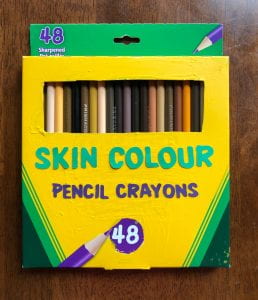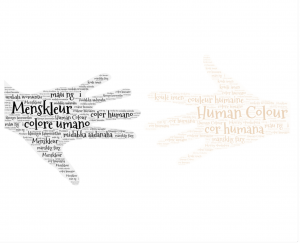As a white person I know I can never truly understand the injustices that a person of colour goes through and I acknowledge my white privilege. This blog post and project are about the research I did to better educate myself about black oppression, injustice and experiences. Hopefully, this blog post can help others educate themselves as well.
When you think of a ‘skin colour’ pencil crayon what colour do you think of?
On Instagram I came across this post:
https://www.instagram.com/p/CBKQWkrhojP/?igshid=q0hun64wmdul
After looking at this post I realized how true this statement is. During some point as a kid, I learned to associate the peach colour pencil crayon as skin colour. This is where the problem starts and as a society, we need to change. As a movement towards change and representation that ‘skin colour’ is not always white, I created a statement art piece to represent this.
A box of pencil crayons that says the words skin colour and includes pencil crayons that are representative of all skin colours. I was initially inspired by the idea of visual representation from our grade 11 unit on conceptual art. This piece signifies that we need to teach all kids about black history and culture in school, while also showing the importance of diversity and loving your skin colour. Children aren’t born racism. They learn it, so if we can be teaching children from a young age about the importance of embracing others, equality and love, we can make a positive change for the future and eliminate racial discrimination and injustices. Although I know that pencil crayon sets like this already exist, I created this in response to the Instagram post I saw and to signify that change needs to happen. After creating the art piece, I decided to research more in-depth about the ‘skin colour’ pencil crayon, and what I came across was a wealth of information. The three that stood out to me were a TED talk, a research article, and the film made called a class divided.
Humanea
The TED talk was a very powerful and moving talk by Angélica Dass called “The Beauty of Human Skin in Every Colour.” While watching, I learned about the significance of her photography project called Humanea, where she captured the beauty and diversity of over 3000 people from 13 counties.
What made this art so extraordinary was how through the power of media, the art was displayed globally in exhibits, news, websites, and publicly on sides of buildings. We see the significance of Humanea as it teaches people of all ages that all skin colours are beautiful. This is definitely a TED Talk that is worth watching!
The Human Colour
The Research Article I read was called ‘The Human Colour: investigating the attitudes and perceptions of learners regarding race and skin colour.’ The study took place in South Africa and look at how grade 3 students perceive skin colour through pencil crayons. Throughout the article, several studies explained that took place within the classes. One of which was where the children were asked to draw a self-portrait of themselves. During this experiment, many of the kids used colours that were lighter than their skin colour to draw themselves. Specifically making the colour of their face much lighter or not even colouring it in at all. Another study that was done within this article was where the grade 3 students were asked to name some colours of pencils crayons. The results were astounding, the majority (91%) of children from the Afrikaan class called the peach coloured pencil crayon ‘skin colour’ or human colour’ or in Afrikaans ‘menskleur.’ These results show that kids, even at a young age, understand the racial divide in our current society. This needs to change so we can have a just society where children can grow up proud and confident of the colour of their skin.
Another issue that was brought up during this research article was when teachers say they “see no colour.” This is a problem because seeing no colour means they aren’t accepting that people have differences, which creates more of an issue. Instead of “seeing no colour,” we need to embrace diversity and teach children diversity and differences are good, but everyone needs to be treated equally.
Class Divided
https://www.pbs.org/wgbh/frontline/film/class-divided/
Class Divided was a film that was about a teacher’s 20-year experiment about racism discrimination of 3rd graders in the classroom. The teacher, Jane Elliott, who created the exercise for her students divided her class into two groups based on their eye colour. Brown eye students and blue eye students. Fro one day, the teachers treated the blue eye students better, giving them more recess time, telling them they were smarter, and giving them more opportunities to do well. The following day the brown eye students were given these privileges, and the blue eye students were treated poorly and told that they were not smart and couldn’t do anything the brown eye students could do. While on the privilege side, many of the students bought into the idea that they were better than the other students; however on the day they were treated poorly, they got a glimpse of what it felt like to be discriminated against. This was such an impactful experience for the children that taught them so much in just two days. When the kids came back later on as adults to talk about the influence and impact of this exercise, it still resonated with all of them to this day. What was interesting is when the children were praised for the school work they ended up doing much better consistently after the experiment ended. This experient shows the influence that teachers have on students at such a young age. If we were to integrate more lessons like this, I think young children would be able to understand inequality and be willing to fight for change.
For this last unit EVER in PLP leading up to this final project, we looked at ‘Politics and Economics’ and ‘ Justice and Revolution’ throughout the 70s until today. Specifically looking at the historical events that could help us answer our driving question ‘How can we as educated citizens fight the power?’ The topics that interested me most were those in the justice and revolution path as I’m very interested in sociology. Learning about historical events throughout this time period has helped me build my knowledge and connect situations to current events.
To ‘fight the power’ we need to come together as one and fight for change. How I’m trying to contribute and do my part is through education. By striving to learn more about black history, listening to podcasts, watching documentaries and researching and signing the petition I will continue to fight for a just society. I am also using my voice to stand up for black lives through social media and speaking to family and friends. I will continue to speak for change as Black Lives Matter is not a trend, inequality and discrimination have been happening for hundreds of years and we need to fight up against it today, tomorrow and the following days until our society is equal.




